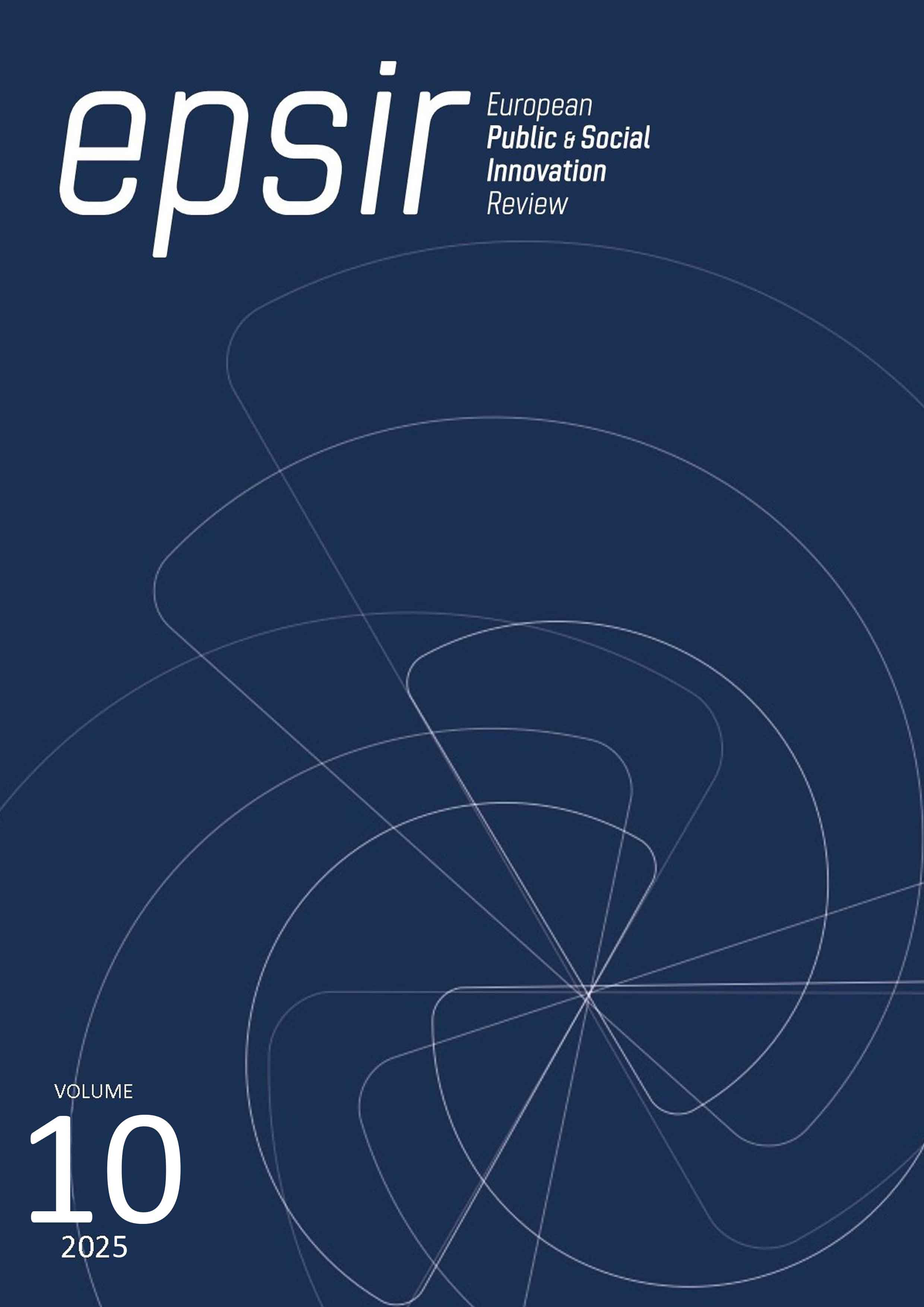Artistic creativity at the service of integrated Didactics
DOI:
https://doi.org/10.31637/epsir-2025-1483Keywords:
Creativity, Didactics, Integration, Musical education, Psychomotor skills, Visual Education, Performance, WorkshopsAbstract
Introduction: This study analyses the collaboration of students from the University of Lleida in the school campaign of the performing arts festival Mil Maneres de Alcoletge, through didactic workshops given by students and supervised by the teaching staff. Methodology: The project focuses on the subject of Artistic Projects, integrating areas such as music, physical, visual and plastic education. The students designed and carried out artistic activities and creations based on creativity and expression, using expository sessions, workshops and group tutorials. Results: The experience allowed the Infant Education and Dual Degree Infant-Primary students to apply their competences in a practical and non-formal context, overcoming the complexity of adapting to a different space and audience than usual. Conclusions: The challenge of adapting to the festival context, as well as the need to develop creative skills in an unstructured environment such as the formal classroom, represented a significant experience for the students, which was expressed in their reflections.
Downloads
References
Alcubilla Troughton, I. (2023). Performing Relations. Performance Research, 28(6), 107-114. https://doi.org/10.1080/13528165.2023.2334649 DOI: https://doi.org/10.1080/13528165.2023.2334649
Burset, S. (2017). La didáctica de las artes plásticas: entre lo visual, lo visible y lo invisible. Didacticae, 2, 105-118. https://doi.org/10.1344/did.2017.2.105-118 DOI: https://doi.org/10.1344/did.2017.2.105-118
Camilleri, F. y Dewsbury, J. D. (2023). On habit and performance. Performance Research, 28(6), 1–11. https://doi.org/10.1080/13528165.2023.2334612 DOI: https://doi.org/10.1080/13528165.2023.2334612
Chen, Y., Yu, C., Yuan, Y., Lu, F. y Shen, W. (2021). The Influence of Trust on Creativity: A Review. Frontiers in Psychology, 12(August). https://doi.org/10.3389/fpsyg.2021.706234 DOI: https://doi.org/10.3389/fpsyg.2021.706234
Cohen, L., Manion, L. y Morrison, K. (2009). Research Methods in Education. In Research Methods in Education (7th ed.). Taylor & Francis e-Library.
Cremin, T. y Barnes, J. (2021). Creativity and Creative teaching and Learning. In Open Research Online (Ed.), Learning to Teach in the Primary School (pp. 1-266). The Open University.
Dávila, C. F., Jiménez, T. C. y Alcalde, D. R. (2020). The performance: An interdisciplinary proposal from the departments of physical education, music education and visual arts education in the initial teacher training. Retos, 37, 613–619.
Departament d’Educació. (2015). Competències bàsiques de l’àmbit de l’educació física. 64. www.gencat.cat/ensenyament
Departament d’Educació. (2022). Curriculum LOLOE Música. Decret 175/2022, de 27 de setembre, d’ordenació dels ensenyaments de l’educació bàsica (pp. 1-9). Generalitat de Catalunya Departament d’Ensenyament. https://acortar.link/NG0Hja
Departament d’Educació. (2023). DECRET 21/2023, de 7 de febrer, d’ordenació dels ensenyaments de l’educació infantil. 1-39. https://portaldogc.gencat.cat/utilsEADOP/PDF/8851/1955221.pdf
Departament d’ensenyament. (2016). Competències bàsiques de l’àmbit artístic (R. Capdevila y J. Serramona (Eds.), Servei de). Generalitat de Catalunya Departament d’Ensenyament. https://acortar.link/DM8Ufm
Giráldez, A. y Díaz, M. (2007). Aportaciones teóricas y metodológicas a la educación musical :una selección de autores relevantes. Biblioteca de eufonía, 240. Editorial Grao.
Hernández Bravo, J. R., Hernández Bravo, J. A. y Milán Arellano, M. Á. (2010). Actividades creativas en educación musical: la composición musical grupal. Ensayos (Facultad de Educación de Albacete), 25, 11-23. http://www.uclm.es/ab/educacion/ensayos
Hernández, J. A., Hernández, J. R., De Moya, M. del B. y Cózar, R. (2014). La educación musical competencial en España: ¿Necesidad o deseo? Music Education based on Competencies in Spain: Necessity or desire? Revista Electrónica Educare, 18(3), 237-249. https://doi.org/http://dx.doi.org/10.15359/ree.18-3.14 DOI: https://doi.org/10.15359/ree.18-3.14
Jeffrey, B. (2006). Creative Teaching and Learning. General Music Today, 10(1), 13-16. https://doi.org/10.1177/104837139601000105 DOI: https://doi.org/10.1177/104837139601000105
Lacárcel, J. (2003). Psicología de la música y emoción musical. Educatio, 20–21, 213-226. http://revistas.um.es/index.php/educatio/article/viewFile/138/122
Lleixà, T. (2017). Didáctica de la Educación Física: Nuevos temas, nuevos contextos. Didacticae, 2, 2–5. https://doi.org/10.1344/did.2017.2.2-5 DOI: https://doi.org/10.1344/did.2017.2.2-5
Ludeña, E. S. (2012). El privilegio de impartir una María | Otras Políticas. https://www.otraspoliticas.com/educacion/el-privilegio-de-impartir-una-maria/
Olvera-Fernández, J., Montes-Rodríguez, R. y Ocaña-Fernández, A. (2023). Innovative and disruptive pedagogies in music education: A systematic review of the literature. International Journal of Music Education, 41(1), 3-19. https://doi.org/10.1177/02557614221093709 DOI: https://doi.org/10.1177/02557614221093709
Pastor, P. (2004). Las marías.www.marchitopensil.boe.es*. Revista Electrónica de LEEME, 14, 1-10. https://ojs.uv.es/index.php/LEEME/article/view/9752/9186
Sawyer, K. (2015). A call to action: The challenges of creative teaching and learning. Teachers College Record, 117(10), 1-34. https://doi.org/10.1177/016146811511701001 DOI: https://doi.org/10.1177/016146811511701001
Tamdogon, O. G. (2006). Creativity in education: Clearness in perception, vigorousness in curiosity. Education for Information, 24(2), 139-151.
https://doi.org/10.3233/EFI-2006-242-303 DOI: https://doi.org/10.3233/EFI-2006-242-303
Tsai, K. C. (2015). A Framework of Creative Education Kuan Chen Tsai. In Education, 21(1), 137–155. DOI: https://doi.org/10.37119/ojs2015.v21i1.193
Tubio, D. (2011). Reflexiones sobre la arquitectura. Eje: Alfabetización En Las Distintas Disciplinas, 39, 113-143. https://books.google.com.mx/books?id=YATUygAACAAJ
Walia, C. (2019). A Dynamic Definition of Creativity. Creativity Research Journal, 31(3), 237-247. https://doi.org/10.1080/10400419.2019.1641787 DOI: https://doi.org/10.1080/10400419.2019.1641787
Downloads
Published
How to Cite
Issue
Section
License
Copyright (c) 2025 Jordi Cano Sobrevals, Berta Fernández Mata

This work is licensed under a Creative Commons Attribution-NonCommercial-NoDerivatives 4.0 International License.
Authors who publish with this journal agree to the following terms:- Authors retain copyright and grant the journal right of first publication with the work simultaneously licensed under Creative Commons Non Commercial, No Derivatives Attribution 4.0. International (CC BY-NC-ND 4.0.), that allows others to share the work with an acknowledgement of the work's authorship and initial publication in this journal.
- Authors are able to enter into separate, additional contractual arrangements for the non-exclusive distribution of the journal's published version of the work (e.g., post it to an institutional repository or publish it in a book), with an acknowledgement of its initial publication in this journal.
- Authors are permitted and encouraged to post their work online (e.g., in institutional repositories or on their website) prior to and during the submission process, as it can lead to productive exchanges, as well as earlier and greater citation of published work (See The Effect of Open Access).




